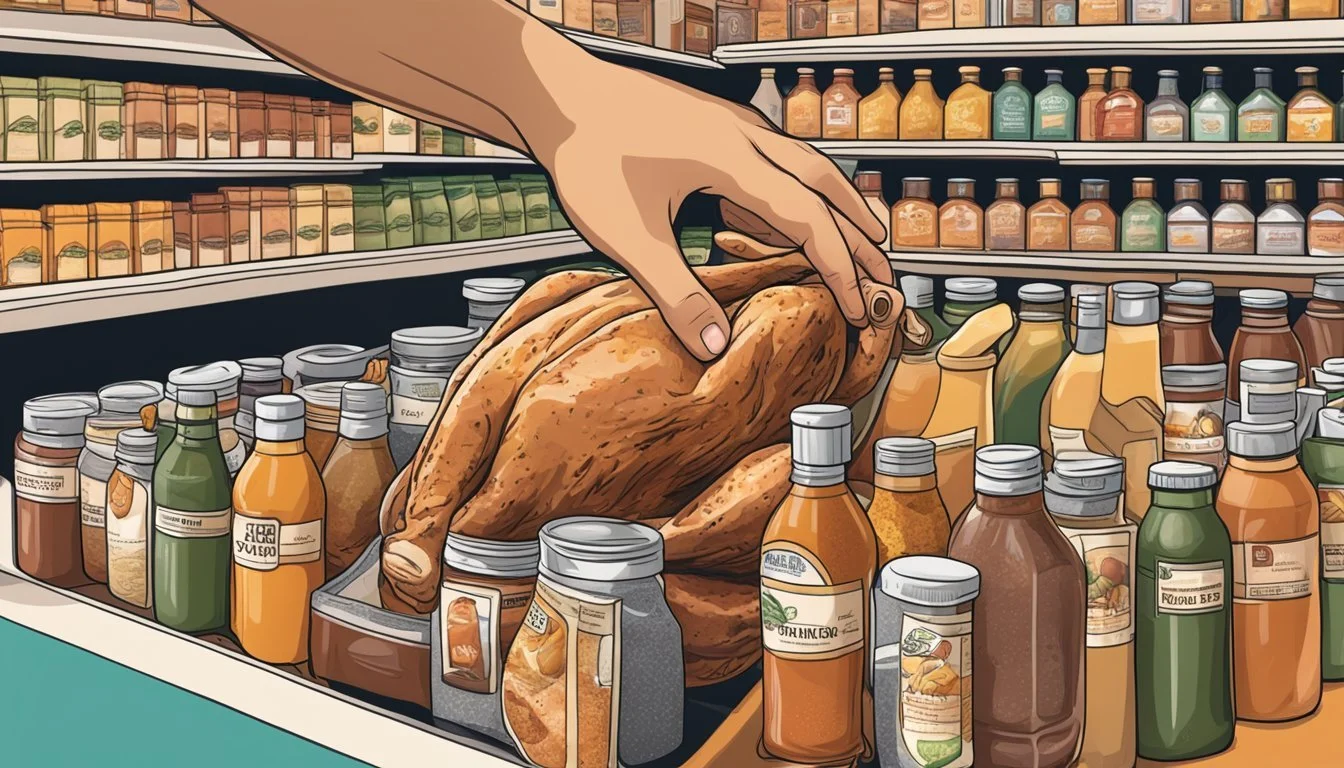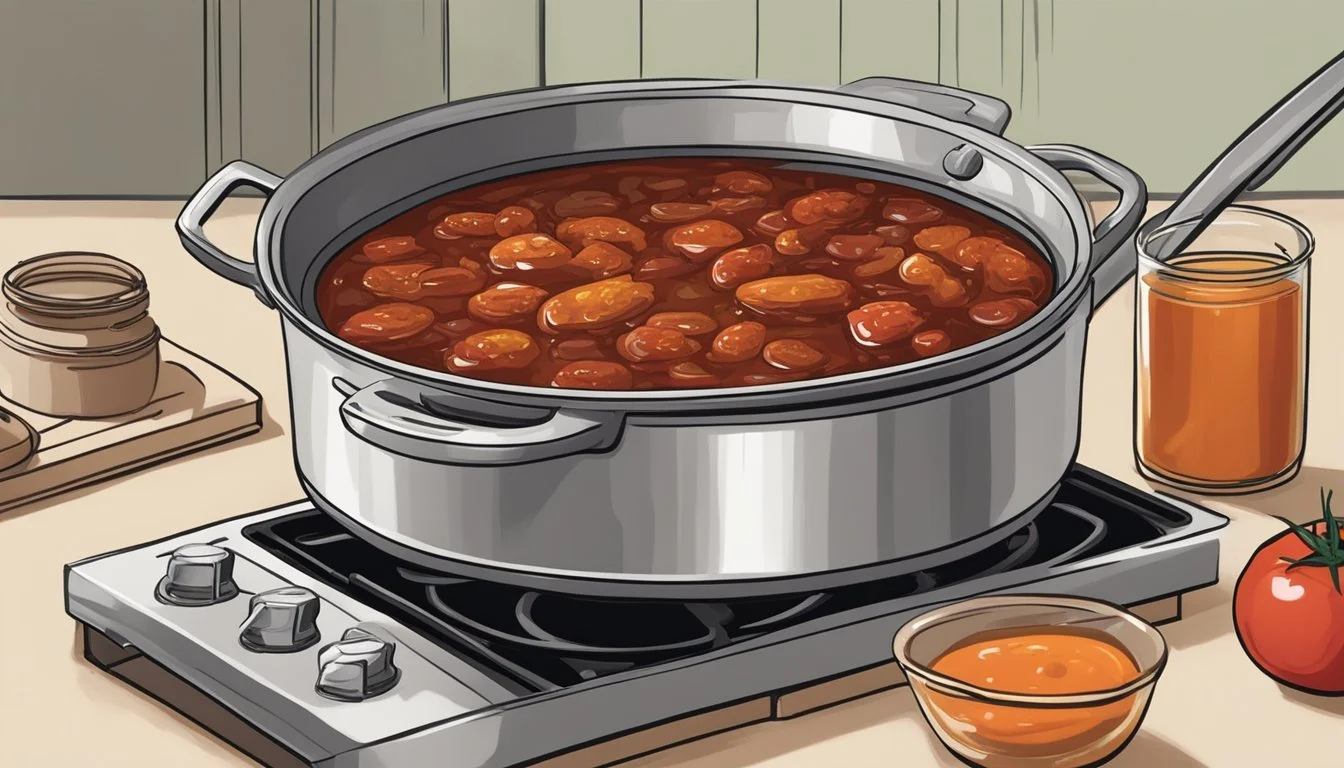How to Make a Lonestar State BBQ Chicken
Your Ultimate Guide to Texas-Style Flavor
Texas, with its rich culinary tradition, has long been celebrated for its unique approach to barbecue (What wine goes well with barbecue?), a style deeply ingrained in its culture. In the Lonestar State, BBQ chicken (how long does chicken last?) isn't just a dish; it's a craft that merges time-honored techniques with a variety of local flavors that differ from Central to East and South Texas. The particular method of slow-cooking over indirect heat infuses the meat with a smoky essence, a hallmark of Texas barbecue that distinguishes it from other regional varieties in the United States.
The preparation of BBQ chicken in Texas style involves a meticulous process of seasoning, cooking, and saucing. The meat is traditionally seasoned with a dry rub that brings together a blend of spices that may vary, but often include ingredients like chili powder, paprika, garlic, and onion powder, harkening to the state's penchant for bold and hearty flavors. A defining characteristic of Texas BBQ is the sauce – a Texas-style barbecue sauce typically has a balance of sweet and tangy flavors with a slight kick, complementing the rub and adding a rich, caramelized coating to the perfectly cooked chicken.
To achieve the quintessential Texas BBQ chicken, the cooking process is just as important as the ingredients. It's about controlling the temperature and smoke to ensure the chicken is tender and juicy on the inside, while having that desirable crispy exterior. Whether it's the smokier mesquite common in West Texas, the hickory in the East, or the post oak in Central Texas, the choice of wood used for smoking can subtly alter the final flavor profile, making each BBQ chicken dish uniquely Texan.
Selecting the Right Chicken
In creating a Lonestar State BBQ Chicken that stands out, the selection of chicken is just as crucial as the preparation and cooking techniques. High-quality chicken ensures that the flavors imparted during smoking and seasoning are amplified and savored.
Choosing Chicken Cuts
For a true Lonestar BBQ experience, chicken thighs (What wine goes well with chicken thighs?) are often recommended. They offer a rich flavor, tend to be juicier, and are more forgiving during longer smoking processes. Thighs can be purchased either bone-in or boneless, but bone-in, skin-on thighs typically retain moisture better and provide a protective layer for the meat, which results in a more flavorful finished product.
Preferred Cuts for Smoking:
Bone-in, skin-on chicken thighs
Whole chickens (for even cooking, spatchcocking is advised)
Understanding Quality and Freshness
The quality and freshness of the chicken have a direct impact on the taste and texture of the BBQ chicken. Always opt for fresh, preferably organic, chicken from a reliable source. Freshness can often be gauged by the chicken's appearance and smell — it should be free of any unpleasant odors and the skin should be a consistent, healthy color.
Indicators of Freshness:
Aspect Indicator of Freshness Smell No sour or ammonia-like odors Color Even coloring, no grayish tones Texture Skin should be supple, not slimy Packaging Date As close as possible to the purchase date
By carefully selecting the right cuts and ensuring the quality and freshness of the chicken, one sets the foundation for a delectable BBQ experience.
Preparing the Chicken
The key to succulent BBQ chicken is meticulous preparation, which involves trimming and cleaning the meat, followed by a thorough brining process to infuse it with flavor and moisture.
Trimming and Cleaning
Before marinating or cooking, it’s essential to properly trim and clean the chicken thighs. They should begin their journey to the grill by removing excess fat and any remaining feathers. This step ensures that the chicken cooks evenly and provides a better texture. One should also rinse the chicken under cold water and pat it dry with paper towels to ensure a clean surface for seasoning.
Brining for Flavor and Moisture
To guarantee that the chicken remains moist and flavorful, a brine solution should be prepared. A basic brine consists of a mixture of salt and water, allowing the meat to absorb extra moisture and seasoning before cooking.
Brine Mixture:
4 cups of water
1/4 cup of kosher salt
Additional seasonings can be added to the brine for more complex flavors. Ingredients like onion and garlic granules, along with signature spices, can be dissolved into the brine to create a deep, rich taste profile. Submerge the chicken thighs in the brine for a few hours, preferably overnight, which allows the salt to break down the proteins, resulting in tender and juicy meat.
Making the Lonestar State BBQ Sauce
Crafting the authentic Lonestar State BBQ sauce involves a harmonious blend of tanginess, sweetness, and a kick of heat. This particular sauce is notable for its bold flavors and signature smokiness.
Selecting Sauce Ingredients
The foundation of this homemade BBQ sauce is tomato paste which serves as a thickening agent and provides a deep, concentrated tomato flavor. Apple cider vinegar and brown sugar are essential for achieving the sauce's tangy-sweet profile, while Worcestershire sauce adds a complex, umami-rich dimension. To ensure a well-rounded flavor profile, spices such as cumin, chili powder, and onion powder are incorporated for warmth, and smoky flavor is typically achieved with ingredients like smoked paprika or liquid smoke.
Ingredients Table
Ingredient Purpose Tomato paste Adds thickness and a rich tomato flavor. Apple cider vinegar Provides tanginess. Brown sugar Offers sweetness to balance tanginess. Worcestershire sauce Gives savory depth and umami. Cumin Introduces warmth and earthiness. Smoked paprika Imparts a smoky nuance.
Cooking and Simmering Techniques
For cooking, start by caramelizing a finely diced sweet onion in unsalted butter; this process brings forth a natural sweetness and complexity. Next, incorporate the garlic powder or fresh garlic to add aromatic undertones. Once the base flavors are established, add the remaining ingredients to the saucepan. The simmering process is crucial for melding the individual elements into a cohesive sauce: a gentle, persistent simmer allows the flavors to marry and intensify while the sauce thickens to the desired consistency.
Cooking Steps
Sauté: Cook onions until golden, then add garlic.
Combine: Stir in the tomato paste, vinegar, sugar, and other seasonings.
Simmer: Reduce the sauce over medium-low heat, stirring occasionally.
Seasoning and Rubs
The right combination of seasoning and rubs can elevate the flavors of BBQ chicken, infusing the meat with a distinctive Texas flair. A well-crafted rub or a flavor-packed marinade sets the foundation for the smoky and savory taste profile characteristic of Lonestar State BBQ.
Dry Rubs and Spice Blends
When crafting a dry rub for BBQ chicken, one starts with a base of smoked paprika for its smoky essence. It is essential to incorporate both salt and pepper to enhance the natural flavors of the chicken. For added complexity, chili powder introduces a mild heat, while cayenne pepper can be used for a spicier kick. Here's an example of a basic Texas BBQ Chicken rub:
2 tbsp smoked paprika
1 tbsp black pepper
1/2 tbsp chili powder
1/2 tsp cayenne pepper
2 tbsp brown sugar (for a touch of sweetness)
1 tsp garlic powder
1 tsp onion powder
Mix these ingredients thoroughly. The rub can be stored in an airtight container and used to season chicken generously before cooking.
Marinades and Wet Rubs
Marinades and wet rubs serve a dual purpose: tenderizing the chicken and imbuing it with flavors. A quintessential Lonestar marinade often begins with an oil base, incorporating spices such as black pepper, paprika, and chili powder for heat and color. Citrus juices or vinegar can also be added to help tenderize the meat. If one prefers a wet rub, it's advised to create a paste-like consistency using the same spices found in a dry rub but with the addition of oil or other wet ingredients to adhere better to the chicken. The chicken should be marinated for several hours, or preferably overnight, to allow the flavors to fully penetrate.
Cooking the Chicken
Preparing Lonestar State BBQ chicken requires attention to method and technique, with the choice of grilling or oven cooking pivotal to infusing the iconic flavors Texans love.
Grilling Methods
Grilling imparts a smoky flavor to barbecue chicken that's hard to mimic with other cooking methods. For authenticity, one should consider using various types of wood such as hickory, mesquite, or oak, which contribute to the overall flavor profile. Marinate the chicken for several hours — ideally overnight — to ensure the meat soaks up the barbecue essence. Here's a structured approach:
Preheat the grill to medium-high heat.
Prepare the grill grates by cleaning and oiling them to prevent sticking.
Place the chicken on the grill, skin side down, and cook uncovered, checking for flare-ups.
Flip the chicken every 5 to 7 minutes, applying the BBQ sauce during the last few minutes to prevent burning.
A good grilling technique involves creating a two-zone fire to manage heat — one side of the grill should be hotter, allowing for searing, while the other is cooler, perfect for slower cooking and smoking.
Oven Cooking Techniques
For a baked BBQ chicken in an oven, the process involves less smoke but can still yield a moist and flavorful dish. Start with these steps:
Preheat the oven to 400°F (204°C).
Line a baking sheet with aluminum foil for easier cleanup.
Season the chicken well before transferring to the oven.
Oven Process Description Marinate Coat the chicken in BBQ sauce for as long as possible before baking. Initial Cooking Bake skin side down to start, allowing the meat to cook thoroughly. Basting Turn the chicken and generously baste with sauce in intervals. Finishing For a crispy exterior, broil the chicken for the last few minutes.
Remember to check the internal temperature of the chicken. It should reach 165°F (74°C) to be safe to eat. The oven technique is ideal for those seeking a hands-off approach while maintaining a delicious outcome.
Additional BBQ Elements
The perfect Lone Star State BBQ chicken experience encompasses more than just the meat; it's enhanced by the selection of sides and sauces. These components add texture, contrast, and a depth of flavor that makes for a well-rounded meal.
Sides and Accompaniments
A traditional Texas BBQ feast includes a range of sides to complement the smoky and savory notes of the barbecue. Options often include:
Coleslaw: A classic choice, coleslaw provides a refreshing crunch and a tangy zip that balances the richness of the BBQ chicken.
Potato Salad: Creamy and hearty, potato salad is a filling side that harmonizes with the spiciness of the chicken.
Corn: Often served on the cob or as part of a corn salad, it brings sweetness and a juicy bite.
Beans: Pinto beans slow-cooked with spices are a staple, giving diners a rich and comforting side dish.
These sides should not only complement the BBQ chicken but also offer a variety of textures and flavors to suit different palates.
Sauces and Variations
The sauce is where Texas BBQ chicken can take on various personas. Here are key varieties:
Original Texas BBQ Sauce: A balance of savory, sweet, and tangy flavors, often including ingredients like vinegar, tomato paste, spices such as salt, smoked paprika, chili powder, and black pepper.
Spicy BBQ Sauce: Incorporates additional elements like hot peppers or extra chili powder for those who enjoy a fiery kick.
Sweet BBQ Sauce: For those with a sweeter tooth, molasses or brown sugar can be added for extra richness.
Sauces can be adjusted to personal preferences, like adding more smoke flavor or creating a chunky texture by refraining from blending the sauce completely smooth. They serve to enhance the succulent flavors of the BBQ chicken, making every bite a memorable one.
Serving and Presentation
Properly serving BBQ chicken enhances its role as a comfort food and capitalizes on its smoky flavor and tender texture. Presentation is key to making the meal visually appealing and can elevate the dining experience.
Carving and Plating
The chef begins by carefully carving the BBQ chicken into leg quarters, thighs, or breast pieces, depending on the preference of the diners. For a professional touch, they ensure each plate receives an equally attractive and substantial portion. Plating should be clean and purposeful, with each piece showcasing the caramelized exterior achieved from the BBQ process.
Arrange the chicken on a warm plate.
Consider the balance of color and spacing to create a visually appealing dish.
Garnishes and Final Touches
The final touches to BBQ chicken involve strategic garnishes that complement the dish. A sprinkling of chopped green onions adds freshness and a pop of color that contrasts beautifully with the rich, brown hues of the BBQ sauce. One might also consider a light drizzle of BBQ sauce over the chicken for added sheen and flavor.
Garnish: Finely chopped green onions.
Sauce: A drizzle of warm BBQ sauce, if desired.
These elements, when combined, solidify BBQ chicken's status as a beloved comfort food while highlighting the chef's attention to detail in both flavor and presentation.
Tips from the Pitmaster
A true pitmaster understands that mastery of BBQ chicken within the Texas BBQ tradition involves precise techniques and flavor development. By adhering to established practices and leveraging well-kept secrets, one can consistently produce outstanding BBQ chicken with bold Lone Star flavors.
Techniques for Consistency
Preparation: Quality begins with selection; pitmasters often opt for hormone-free, free-range chickens for a superior base taste. Immersing the meat in a brine solution overnight ensures consistent moisture retention and flavor penetration.
Temperature Control: They maintain a low and steady smoker environment, around 225°F, which cooks the chicken evenly without drying it out. Measuring the internal chicken temperature to reach 165°F guarantees both safety and juiciness.
Secrets to Enrich Flavors
Robust Rubs: The foundation is frequently a bold rub made from equal parts salt and black pepper, with a quarter part paprika. Adding chili powder and cayenne introduces a classic Texas heat profile.
Wood Selection: Flavorful smoke arises from the right choice of wood; Lone Star pitmasters might favor mesquite or hickory to infuse the meat with a deep smokiness that’s essential to Texan cuisine.








